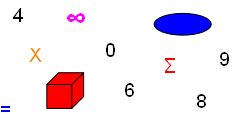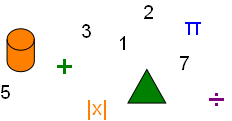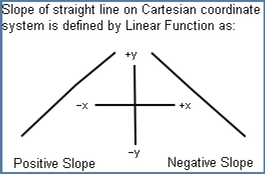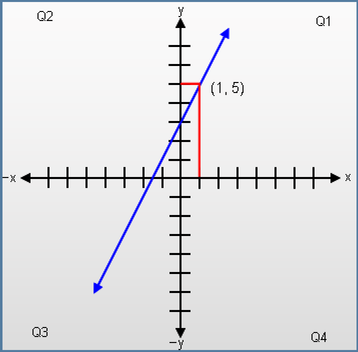



Linear Functions


The Linear Function provides a convenient method to determine behavior of a sloping straight line on a Cartesian Coordinate System before drawing a graph using rectangular coordinates. It is function math for a Linear Equation.


y = 0 = 2x + 3 then
x = −3/2
The Linear Function defines sloped straight lines as:
f(x) = ax + b and a ≠ 0, for all real numbers.
a is slope. b is the y intercept, the value of y when x = 0.
When a is:
1. > 0; the graph line is rising, a positive slope.
2. < 0; the graph line is falling, a negative slope.
When b is:
1. > 0; the graph line is above a Cartesian coordinate origin,
(0, 0), when intersecting the y axis.
When x = zero then
y > zero.
2. < 0; the graph line is below a Cartesian coordinate origin
when intersecting the y axis. When x = zero then y < zero.
3. = 0; the graph line passes through a Cartesian coordinate origin.
When b ≠ 0 there exists an x intercept when y = 0.
The Linear Function does not define:
1. A horizontal line; When a = 0, then f(x) = b, a constant.
f(x) = c is the Constant Function.
2. A vertical line; Slope a would be infinite.
Linear Function Examples
f(x) = ax1 + b
g(x) = ax2 + b
h(x) = ax3 + b
Where x1 ≠ x2 ≠ x3
f(x), g(x) and h(x) are different points on the same line as unique (x, y) coordinates. Their a and b values of all linear functions are the same.
Let a = 2 and b = 3;
y intercept is value of b and graph coordinate (0, 3).
Replace f(x), g(x) and h(x) math functions by y, then for all values of x;
y = 0 = 2x + 3
2x = −3
x = −3/2
x intercept when y = 0 is: −1 ½
f(x) = ax + b1
g(x) = ax + b2
Where b1 ≠ b2,
Lines f(x) and g(x) are parallel separated by the absolute value of any perpendicular between b1 and b2.
f(x) = a1x + b
g(x) = a2x + b
Where a1 ≠ a2,
Lines f(x) and g(x) intersect at exactly one point (0, b). It is the only value for x that provides the same y for both linear functions:
f(x) = g(x) when x = 0
f(x) = a1x + b
g(x) = a2x + b
Where a1 ≠ a2 and a2 < 0
Line f(x) has positive slope and line g(x) has negative slope. f(x) and g(x) intersect at exactly one point; (0, b). It is the only value for x that provides the same y for both functions:
f(x) = g(x) when x = 0
Linear Function Identity
When a = 1 and b = 0 then y = f(x) = ax
Its graph is a straight line passing through a Cartesian coordinate origin, bisecting at 45 degree right angles the first and third quadrants.
Copyright © DigitMath.com
All Rights Reserved.